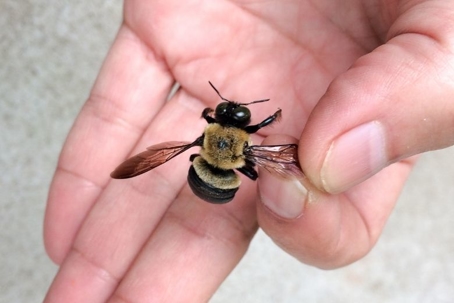Can Carpenter Bees Sting?
Yes, carpenter bees can sting, but there are a few important nuances:
Female carpenter bees have stingers and can deliver a painful sting if they feel threatened or provoked. The sting is similar to those from honeybees but generally less likely to trigger severe reactions unless someone is allergic.
Male carpenter bees do not have stingers. These bees can be aggressive in defending their territory, buzzing loudly and chasing intruders, but they cannot sting.
Do Carpenter Bees Sting?
Carpenter bees are generally not aggressive and will usually sting only as a last resort. Here are the main situations where a sting is most likely:
Direct handling or provocation – Touching, grabbing, or trying to swat a carpenter bee can trigger a defensive sting from females.
Nest disturbance – Female carpenter bees sting to defend their nests. If you are drilling, sanding, or otherwise working near the wooden structures where they are nesting, the risk increases.
Feeling trapped or cornered – Bees that are accidentally trapped indoors or against your skin may sting in self-defense.
Sudden close proximity to flowers or food sources – Although rare, females foraging can sting if they perceive a threat while feeding.
Male bee “territorial behavior” – Male carpenter bees cannot sting, but they may dive-bomb or chase intruders. People often think they’ve been stung when it’s actually intimidation behavior.
In general, female carpenter bees sting only when directly threatened, and the best way to avoid stings is to not handle them and keep a safe distance from their nesting sites.
Carpenter Bee Stings
Carpenter bee stings are typically mild to moderate in severity, especially compared with stings from wasps or some hornets, but the reaction can vary depending on the person:
Pain Level
A carpenter bee sting usually causes sharp, localized pain similar to a honeybee sting.
Pain generally subsides within a few minutes to an hour.
Some people describe it as a quick “jab” that burns slightly.
Local Reactions
Redness at the sting site
Swelling around the area
Itching or mild burning
Tenderness lasting several hours
In most cases, these symptoms are self-limiting and resolve within a day or two.
Severe Reactions
Allergic reactions are rare but possible. Signs include:
Widespread hives
Swelling of lips, tongue, or throat
Difficulty breathing
Dizziness or fainting
Anyone with a known bee allergy should treat carpenter bee stings as potentially serious and seek immediate medical attention.
Comparison with Other Stings
Carpenter bee stings are usually less severe than wasp or hornet stings, which often inject more venom.
The reaction is often similar to a honeybee sting, though honeybees leave their stinger behind, which can increase venom exposure. Carpenter bees do not leave a stinger, so the venom dose is limited.
For most people, a carpenter bee sting is painful but manageable, with minor swelling and redness. Severe reactions are uncommon but require urgent care.
What Do Carpenter Bee Stings Look Like?
A carpenter bee sting usually produces a small, localized reaction rather than anything dramatic. Here’s what to expect:
Immediate Appearance
Small puncture mark in the center of the sting site (sometimes barely visible).
Redness around the area.
Mild swelling or a raised bump (similar to a mosquito bite).
Slight bleeding is possible but uncommon.
Within a Few Hours
The area may become more inflamed or warm to the touch.
Itching or a mild burning sensation is common.
The bump may harden slightly as your body reacts to the venom.
1–2 Days Later
Redness and swelling usually peak within 24 hours and then start to subside.
The puncture mark may form a tiny scab.
Most reactions resolve without complications within a couple of days.
Severe or Allergic Reactions (Rare)
Widespread redness or hives beyond the sting site.
Swelling of the face, lips, tongue, or throat.
Difficulty breathing, dizziness, or fainting.
A typical carpenter bee sting looks very much like a small bee sting or wasp sting—a tiny red bump with mild swelling, not unlike a mosquito bite but slightly firmer.
What To Do About Carpenter Bee Stings
If you get stung by a carpenter bee, the treatment is generally straightforward, since these stings are usually mild:
Remove the Bee (if present)
Unlike honeybees, carpenter bees do not leave their stinger behind, so usually there’s nothing to remove.
If there’s any debris or venom residue, gently wash the area with soap and water.
Clean the Area
Wash the sting site with mild soap and water to reduce the risk of infection.
Pat dry with a clean towel.
Reduce Pain and Swelling
Apply a cold compress or ice pack wrapped in a cloth for 10–15 minutes at a time.
Elevate the affected area if possible to minimize swelling.
Over-the-counter pain relievers like ibuprofen or acetaminophen can help with pain.
Soothe Itching or Irritation
Apply a topical antihistamine cream, hydrocortisone cream, or calamine lotion to reduce itching and inflammation.
Avoid scratching, which can increase irritation or risk of infection.
Monitor for Allergic Reactions
Most people experience only localized reactions, but seek immediate medical attention if you notice:
Widespread hives
Swelling of lips, tongue, or throat
Difficulty breathing or swallowing
Dizziness, fainting, or rapid heartbeat
Natural Remedies (Optional)
A baking soda paste (baking soda + water) can neutralize venom and reduce itching.
Aloe vera gel can soothe pain and inflammation.
When to See a Doctor
If pain, swelling, or redness worsens over 24–48 hours, it could indicate infection.
If you have a known bee allergy, even a mild sting should be treated as potentially serious.
For most people, a carpenter bee sting is painful but manageable at home. Clean, cool, and soothe the area, monitor for allergic reactions, and seek medical care if symptoms are severe or prolonged.

